Headphone Calculator for Android
By Rob Robinette
The Headphone Calculator© is free and available here in the Google Play Store.
You can also download the latest version directly from this website: Headphone Calculator for Android apk
This calculator has two primary functions: The 'Headphone Resistor Network Calculator' page will help you determine the optimum resistor values for a headphone-to-speaker amplifier interface which will electronically match your headphones to a speaker amplifier using a resistor network. The resistor network used in this app is a simple L-pad attenuator and is the most commonly recommended headphone-to-speaker-amp resistor network interface. The headphone 'Power Calculator' page will calculate headphone power, current and voltages.
Click the 'Go to Power Calculator' or 'Go to Network Calculator' buttons to switch between the two calculator pages. Click the 'Help' button to get context sensitive help.
Headphone Resistor Network Calculator Instructions
1. Enter the values in yellow including your Headphone's Impedance rating, your Amplifier's Speaker Load rating (usually 4 or 8 ohms) and the Amp's Output Impedance (if you don't know the exact value leave it at 0.1).
2. Click the 'Calculate' button. Any time a value is changed the 'Calculate' button must be clicked again.
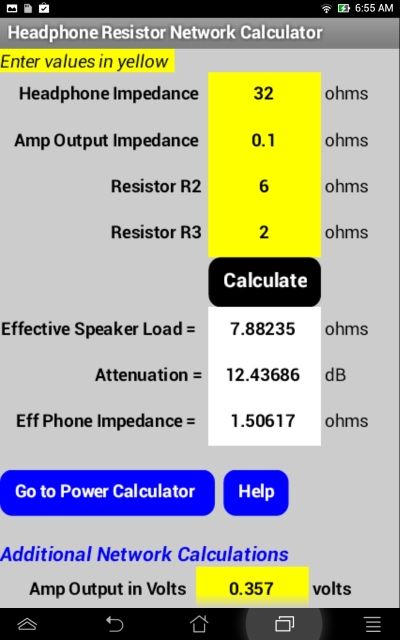
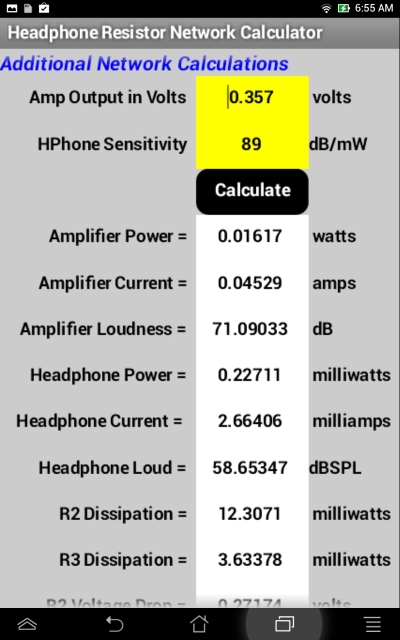
Effective Speaker Load is the load your amplifier 'sees.' The goal is to match this to your amplifier's speaker load rating (usually 8 ohms).
Attenuation is the reduction in decibels the resistor network provides.
Eff Phone Impedance is the Effective Headphone Output Impedance.
A Resistor 2 value of 6 ohms and Resistor 3 value of 2 ohms will be close to optimal for most headphones and speaker amps but be sure and play around with the value of Resistor 2 and Resistor 3 and recalculate to see what happens. The greater the ratio between Resistor 2 and Resistor 3 the higher the amplifier Attenuation. Resistor 2 should be rated at 5 watts and Resistor 3 should be rated at 3 watts. Both should be wirewound non-inductive resistors.
The amplifier Attenuation value is used to indicate how much of your amp's power will be dissipated by the network and lower its output to the headphones. The higher the Amp Attenuation the lower the amp's output which can help in two ways. More Attenuation can help reduce the amp's noise floor hiss that can sometimes be heard using headphones (especially sensitive headphones) with speaker amps. A common problem with using a speaker amp with headphones is lack of volume control because a little knob movement can give a big volume increase. Adding amp attenuation can give you more usable volume knob movement.
Additional Network Calculations
3. For Additional Network Calculations enter your amplifier's output voltage and Headphone Sensitivity (in dB/mW) and click 'Calculate'. If your headphone manufacturer lists sensitivity in dB/V you can use the 'Power Calculator' page to calculate the equivalent value in dB/mW.
Amplifier Power is the amp output in watts into the Effective Speaker Load.
Amplifier Current is the amp output in amps into the Effective Speaker Load.
Amplifier Loudness is the dB level when driven into the Effective Speaker Load.
Headphone Power is the milliwatts going through the headphones.
Headphone Current is the milliamps going through the headphones.
HPhone Loudness is the loudness of the headphones in dB SPL (decibel Sound Pressure Level).
R2 Dissipation is the power in milliwatts used up by resistor R2.
R3 Dissipation is the power in milliwatts used up by resistor R3.
R2 Voltage Drop is the drop in voltage across resistor R2.
R3+HP Voltage Drop is the drop in voltage across resistor R3 and the headphones.
Preferred Headphone Resistor Network Interface
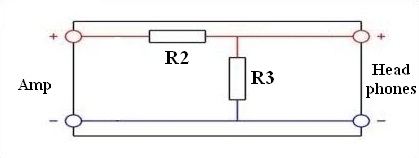
This is the resistor network for headphones with a 4-wire balanced headphone cable. You will need two of these circuits, one for each stereo channel. The amplifier speaker terminals are shown on the left, resistor R2 is on the + headphone wire, resistor R3 bridges the + and - headphone wires and the headphones are on the right.
Preferred Headphone Resistor Network Interface for a 3-Wire Headphone Cable
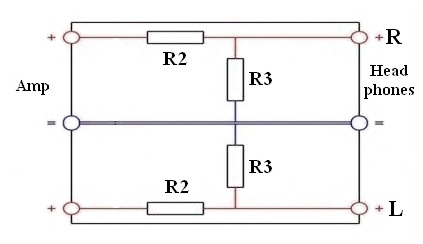
This is the resistor network for headphones with a standard 3-wire single-ended (unbalanced) headphone cable. The middle negative (-) wire is a 'common ground' shared by the Left and Right stereo channels.
This calculator is also available in a much more detailed Excel .xls spreadsheet: Headphone Resistor Network Calculator or OpenOffice version.
For information on building a headphone-to-speaker amp interface see the Robinette Box page.
Headphone Power Calculator Instructions
1. Enter the values in yellow including your Headphone's Impedance rating and Sensitivity rating in dB/mW (decibel per milliwatt). If your headphone manufacturer lists the sensitivity rating in dB/V (decibel per volt) select the dB/V CheckBox. The following calculations assume the headphones are connected directly to your amplifier's speaker terminals without a resistor network interface.
2. Click one of the 'Calculate' buttons. Any time a value is changed a 'Calculate' button must be clicked to recalculate.
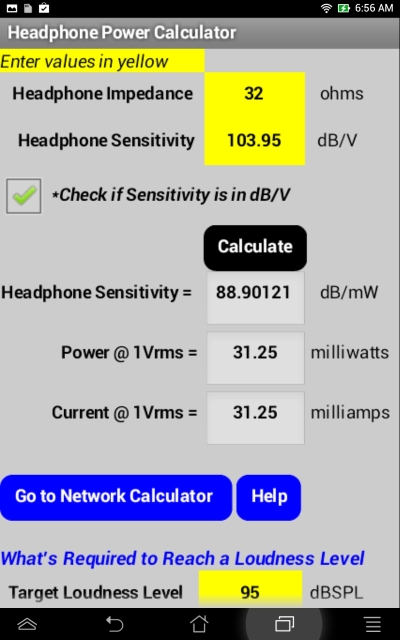
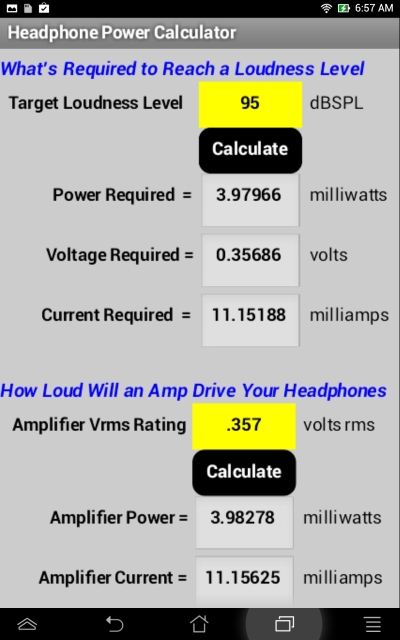
Headphone Sensitivity is the equivalent of what you entered in the yellow box--if you enter sensitivity in dB/mW (CheckBox not checked) it will be converted to sensitivity in dB/V. If you enter dB/V and check the CheckBox then it will be converted to dB/mW.
Power @ 1Vrms is the power in milliwatts running through the headphones when a 1 volt (root-mean-square averaged) audio signal is applied to them.
Current @ 1Vrms is the current in milliamps running through the headphones when a 1 volt audio signal is applied.
What's Required to Reach a Loudness Level
Enter your Target Loudness Level in dBSPL (decibel Sound Pressure Level) and click any 'Calculate' button.
Power Required is the amplifier output power in milliwatts required to get your headphones to the Target Loudness Level.
Voltage Required is the amplifier output voltage in volts required to get your headphones to the Target Loudness Level.
Current Required is the amplifier output current in milliamps required to get your headphones to the Target Loudness Level.
How Loud Will an Amplifier Drive Your Headphones
Enter your amplifier's Vrms output rating in volts and click any 'Calculate' button.
Headphone Loudness is how loud your headphones will play in dBSPL (decibel Sound Pressure Level).
Amplifier Power is the amplifier power output in milliwatts.
Amplifier Current is the amplifier current output in milliamps.
This app does not use or accesses any data or files on your phone. See the official privacy policy.
This calculator is also available as an .xls spreadsheet: Headphone Power Calculator Spreadsheet or OpenOffice version